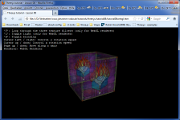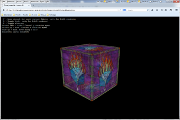| Tutorial 07: Texture filtering, lighting and keyboard | Tutorial 09: Moving bitmaps in 3D space | ||
Tutorial 08: Blending
This tutorial assumes, that you have read and understood lesson 07.Now it's time to see how blending works.
To see the lessons result, you can jump to the live example
 Screenshot of the WebGL renderer |
 Screenshot of the canvas renderer |